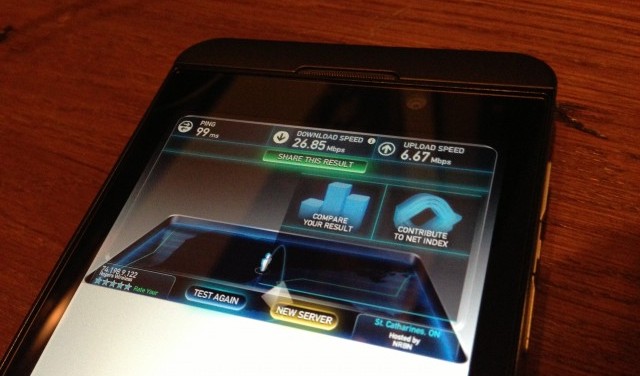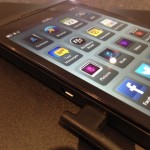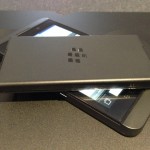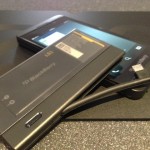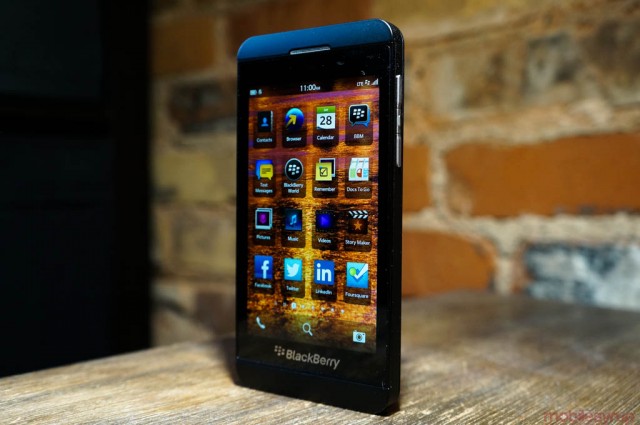

It’s Wednesday, January 30th and unseasonably warm in Toronto. RIM has just nailed a presentation more than two years in the making. BlackBerry 10 is here, and the Z10 is its first representative.
It is difficult to talk about the BlackBerry Z10 in isolated terms. Yes, the phone resembles a modern smartphone is every possible way — high-definition screen, dual-core processor, LTE support, NFC connectivity — but it represents so much more to the company behind it. RIM needs this phone to do well; its success or failure will play an integral part in deciding the future direction of the company from both a hardware and software services perspective.
BlackBerry 10 is the long game: it will evolve over time, as the code itself grew from its QNX roots. But the BlackBerry Z10, RIM’s first consumer handset in nearly two years, must stand on its own. Its design, its internal specs, its innate qualities, must compete with so many other high-end smartphones on the market today. With that in mind, and with BlackBerry 10 in the fore, let’s take a look at RIM’s new superstar.
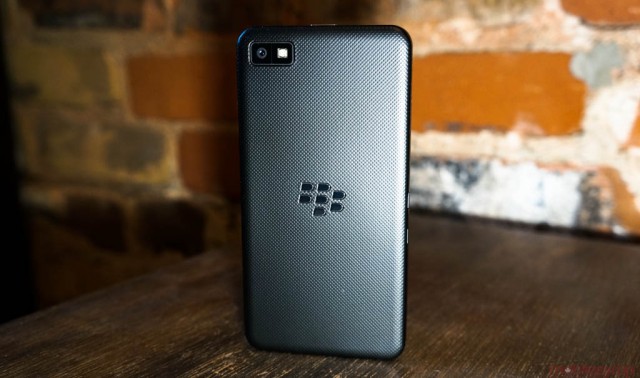
Specs
– BlackBerry 10 OS
– 4.2-inch 1280×768 pixel TFT display
– 1.5Ghz dual-core Qualcomm Snapdragon S4 SoC
– 2GB RAM / 16GB internal storage (w/ microSD)
– 8MP BSI back camera / 2MP front-facing camera
– 1080p video capture @ 30fps
– WiFi (b/g/n), Bluetooth 4.0, A-GPS/GLONASS, NFC
– 1800mAh removable battery
– 130mm x 65.6mm x 9mm
– 135.4 grams
– 3G (850/1900) / LTE (700/AWS)
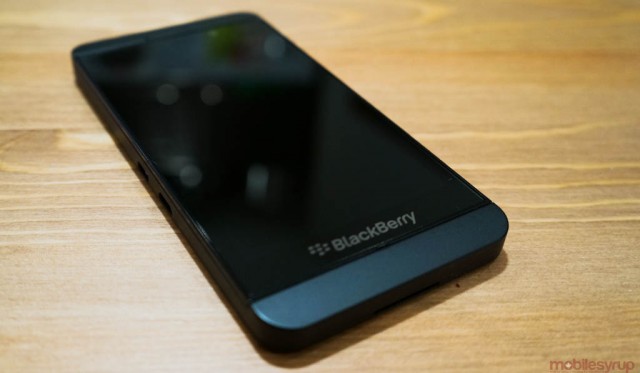
The Hardware
RIM has resurfaced not only with a new smartphone operating system but an entirely new design ethic. The BlackBerry Z10 is a complete departure from anything the company has produced, including the PlayBook; it may at first appear to be another “thin black slab,” the type of unassuming smartphone that so many OEMs are creating these days, but it’s no such thing.
The Z10 has a distinctive face, with curved corners and an inner bezel separated into three parts. The top and bottom sections enjoin the chassis itself, breaking away from the 4.2-inch LCD display with clean lines. The device itself is taller than its screen size would belie, due in large part to the oversized bezel surrounding the LCD itself. BlackBerry 10 relies heavily on outside-in gestures, so RIM likely thought it prudent to markedly separate the display from the perimeter of the phone. While some may find the screen size disappointing in relation to the device’s overall dimensions, the front is so well balanced, with soft edges and perfect symmetry, that it never feels ungainly in the hand.
With a familiar BlackBerry logo below the screen, there is no carrier branding to be found on the Z10. The display is four-point multitouch, with excellent viewing angles and bright, accurate colours; it more accurately resembles the Super LCD 2 display of the HTC One X than the AMOLED type found on the Galaxy S III. The 356ppi pixel density is sharper than the iPhone 5, though it doesn’t match the ridiculous 440+ found on recently-announced Android products like the Sony Xperia Z. It’s a solid display that gets the job done without breaking new ground in the process; RIM did its due diligence, aware during the design process that the Z10 would have a high-definition screen competitive with its smartphone counterparts. However, like Nokia’s Lumia 920, the Z10’s screen responds to gloved hands, a feature sure to be appreciated by cold-weather Canadians.
At 135g and 9mm thick, the Z10 is well proportioned. Its plastic frame lends it a lightness that I appreciated when typing long messages — it’s less tiring on the fingers resting behind the phone — and it feels perfectly balanced for its size. This is an aspect of the phone RIM took a lot of pride in, as representatives were not shy about pointing out that, to excuse a poor reference, there is more to the Z10 than meets the eye.

We find the microUSB and miniHDMI ports on the left side of the device; the volume buttons with a middle play/pause key that doubles as a voice assistant activator are on the right side; the top houses a 3.5mm headphone jack, power button and noise cancelling microphone; and the bottom contains the mono speaker and main clip for the battery cover.
Like all previous BlackBerry smartphone and, with clear sights on its utilitarian roots, the Z10 has a removable battery cover with a replaceable battery cell. The new battery, LS1, is taller and narrower than in previous RIM products and, at 1800mAh, is slightly larger. While I’d have preferred more raw energy to work with, as you’ll see shortly the BlackBerry Z10 performed well in our extensive battery tests, often lasting a full workday day on per charge.
The back cover is made of a sturdy, bendable plastic that is not unlike the Galaxy Note in terms of thickness and pattern. Its ribbed texture allows for a comfortable grip in the hand, and while it would have been nice to see something akin to the gorgeous battery door of the Bold 9900, RIM is keeping its legacy design for the BlackBerry X10. The unmarked — and unmistakable — BlackBerry logo sits in the centre of back cover, a glossy reminder of the company’s inveterate confidence (hubris?). We also find the 8MP camera on the back, near the top left, with a small LED flash to its right. It’s an austere and largely effective design, eschewing frills in exchange for business mindedness. It’s troubling that the camera sits so closely to the volume keys, which function as de facto camera shutter buttons; the camera app does not have a shutter, relying on an autofocus/touch anywhere mechanism that feels finicky. I often found myself wanting to use left-most volume button as a shutter key, only to cover the lens with one of the fingers on my left hand. Using my right hand to hit the shutter key forces you to cover half the screen in the process. There is no one ideal solution to taking photos, just a number of irksome implementations.
The top-mounted power button is not ideally placed, especially for those with smaller hands, requiring a slight readjustment of the phone in the hand. But the power button will likely be used half as often as on a regular smartphone, as turning on the Z10 requires a mere swipe from the bottom. This gesture-based interaction extends to much of the BlackBerry 10 interface, and is a key differentiator from other operating systems like Android and iOS. But gestures don’t entirely replace the back button, which appears in most native apps on BB10.
Ultimately, the BlackBerry Z10 may not have the forward-thinking design loyalists were expecting after such an arduous wait, but it strikes an effective balance between business and personal. It’s a well-made and nicely-designed phone that won’t win any awards for either category but assures that BlackBerry 10 has a modest and clean canvas on which to excel. The dual-toned colour scheme is attractive and the ribbed back cover is comfortable; the removable battery is appreciated and the play/pause button is intriguing.
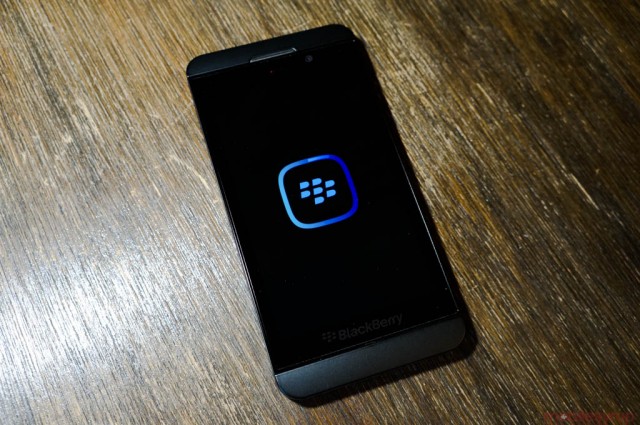
Performance
It’s difficult to make substantive comparisons to other operating systems’ performance, but the Z10 is a huge improvement over previous BlackBerry devices. This is not the BlackBerry OS you grew increasingly disenchanted with over the years; BlackBerry 10 is built on stronger stuff.
Without getting too technical, BlackBerry 10 was created with the touchscreen in mind, and is able to parse more data much more effectively than its Java-based predecessor. The four-point multitouch display responds to input instantly; the virtual keyboard is one of the most accurate and intelligent ever produced; app load times are low and framerates in 3D games are high. In other words, BlackBerry 10 can do everything an iPhone or Android device can do and needs slightly less power to accomplish it. That is because its code structure, based on the versatile QNX operating system, is extremely power-efficient, and RIM has built a wealth of standards support on top of this architecture. If BlackBerry OS was a swaying tower fashioned from particle board, BlackBerry 10 is a low-rise built with steel and granite.
But we’re used high-performance mobile operating systems: iOS, Android and Windows Phone are smooth, beautiful and power-efficient. BlackBerry 10 differentiates itself by being able to do more things at once, in the background, with little penalty to the battery. Its emphasis on true multitasking is one of the best features of the operating system; background apps return to the fore instantly.

Because there are few cross platform benchmark tools available for mobile devices, I settled for Javascript-based tests. While these don’t tax the respective devices’ graphics processors as much as I’d like, they give a rough indication of where the Z10 stands in relation to the each respective platform’s current best hardware. The BlackBerry Z10 contains a 1.5Ghz dual-core Snapdragon S4 8960 SoC with an Adreno 225 GPU, the same part found in the Lumia 920, but the two devices inspire markedly difference results. Much of it can be chalked up to specific browser optimizations, but the reality is that the BlackBerry Z10 is relatively underpowered when compared to the quad-core Nexus 4 and the Cortex A15-like speeds of the iPhone 5. Even Nokia’s Lumia 920 elicits higher scores in two of the three benchmarks.
But the BlackBerry Z10 doesn’t perform poorly — far from it. Instead, it seems that the operating system has been heavily optimized for this particular chip, and I noticed little to no slowdown outside of a few buggy launch-day apps and the occasional poorly-scrolling Android port. BlackBerry 10 flies: apps launch instantly, the camera shutter is beyond fast and, at the end of the day, I rarely felt wanting for speed. It’s a shame there are no graphics-heavy titles with which to test the GPU, but games like Angry Birds Star Wars and Great Big War Game were indistinguishable from their Android and iOS counterparts.
I did encounter an issue with device temperature, however: after a few minutes of heavy activity, whether playing a round of Radiant or browsing a Flash-heavy webpage, the Z10 warmed up considerably, almost to the point of being unusable. It’s not just the back side that’s an issue; the LCD display itself was uncomfortably hot, forcing me to have to put down the phone for a few minutes while it cooled. This only happened during high-load situations, but it may be a serious flaw in the phone’s design.
The operating system’s speed was best felt when ambling through web pages. The native rendering engine is outstanding, providing a close-to-desktop browsing experience. Pages load quickly and, even with Flash turned on, scrolling never gets bogged down. Similarly, typing on the keyboard never gets backed up, unlike even the most powerful Android devices. The operating system intelligently prioritizes the foremost app while adroitly allowing background processes to continue; BB10 lives and breathes on its ability to notify.
To that end, the ability to “Peek” and “Flow” at any time is a huge boon to productivity. I didn’t believe it would be the case until I spent a few days with the Z10, but being able to swipe up from the bottom to check for unread notifications and quickly get back to work or play is tremendously useful.
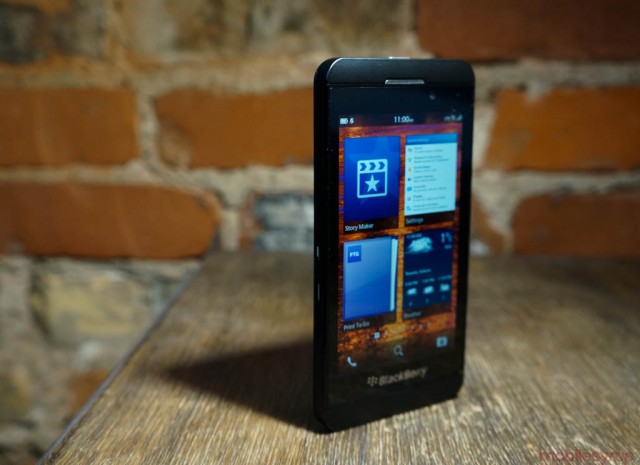
Software
We’ll cover the BlackBerry 10 OS more in-depth in our feature review but, to put it mildly, this is an outstanding mobile experience. Not only are the first-party apps such as Contacts, Calendar, Pictures, Music, Videos, Docs To Go, and the Browser competitive with all the current major mobile operating systems, but there is a level of polish here that we’ve never seen from RIM.
Leave behind for a moment the talk of “Is it enough?” and “Too little, too late?” and let’s talk about how BlackBerry 10. In many ways the interaction is similar to what you’d find on iOS and Android, with a dash of webOS thrown in there. There is a large grid of app icons available to open at any time, with a permanent three icon dock at the bottom with access to Phone, Search and the Camera. To the left of the horizontal app launcher is a multitasking screen comprised of a maximum of eight Active Panes, each one capable of storing and displaying a bit of information. Think of these panes as Windows Phone Live Tiles with a dash of Android’s widget functionality thrown in. For example, BlackBerry World will cycle through featured apps while BBM will show status or avatar updates. It’s simple and useful.
To the left of the multitasking menu — or, by swiping up and to the right from inside any app — is the Hub. This is RIM’s killer app, its pièce de résistance, and will appease all you current and former BlackBerry addicts. It’s the area of the phone that consolidates notifications — all of them — into one area. Email, texts, Facebook, Twitter, LinkedIn, Google Talk. The list goes on, as developers can plug into the Hub API for better integration with the notification system. Sure, the famous red LED still blinks; yes, the app icon still alights with infamous BlackBerry Spark star. These familiar assets act as the bridges that connect BlackBerry OS to BlackBerry 10; so much is different, and yet you can be sure that, either for work or play, your email, texts and social networks are as thoroughly integrated into the operating system as they’ve ever been.
As expected, the BlackBerry 10 email integration, along with the new virtual keyboard, is the best in the game. Typing is fluid and intuitive, and the email workflow just feels right. There were a couple instances of “Man, I wish they had this feature,” but they seldom cropped up. Notifications from non-native email accounts like Gmail were on par with the native app on iOS and Android, and adding the account to the Z10 also synced the calendar and contact list using CalDAV and CardDAV respectively.
Then there’s support for the enterprise, that much-neglected segment of the market likely to go nuts for BlackBerry 10. With Exchange Activesync support and the best VPN integration in the game, alongside legacy and new BlackBerry Enterprise Service compatibility, the Z10 stands to be an excellent work-issue smartphone. Where it may be hard to convince consumers to migrate from iPhones and Androids back to BlackBerry, existing BB users are in for a treat. BlackBerry Balance provides user accounts for work- and home time, allowing IT administrators to disable certain functionalities such as the camera during work hours. BlackBerry Protect provides remote administration and phone finding in addition to basic backup. With new apps launching for Windows and OS X, BB10 is increasingly showing itself as a platform, not just an operating system.
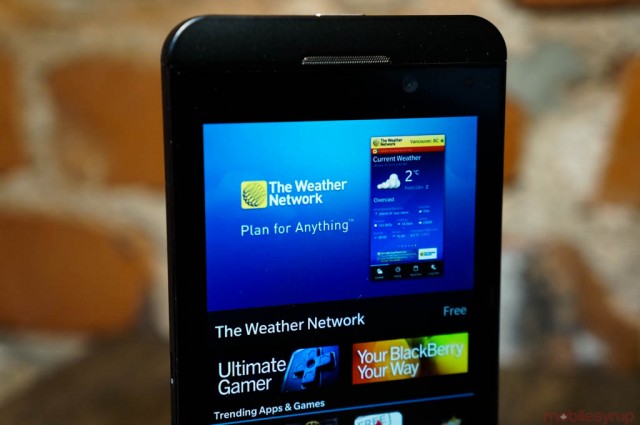
Where the BlackBerry Z10 currently falls short is in its app selection. While RIM promised 70,000 apps on launch day (and we promise to evaluate the situation again shortly thereafter), there is a dearth of truly great software for the platform. While providers such as Flixster, The Weather Network, Slacker Radio, CBC, Rogers, The Globe & Mail, Angry Birds, along with Twitter, Facebook, LinkedIn and Foursquare, are all available out of the box, I found that either the apps lost features in the move from iOS or Android, or they were somewhat buggy and underdeveloped. It’s great to see name brands on day one, especially ones that I use on other platforms, but it appears that the long tail has formed early on BlackBerry 10, and users are going to wonder what all the fuss was about. It’s a remarkable achievement to see such a diverse array of apps on a brand new mobile platform, but the pull from Android and iOS is so fierce, and a strong app library is at the top of the list.
I must say that using BBM again after so long was both a joyful and disheartening experience. Like any homecoming, things are the same and yet you’ve changed, moved on. Such is the current state of my BBM list; after logging in with my BlackBerry ID, which synced the contacts I’d since abandoned to other messaging apps, I found 16 people. At the height of my BlackBerry usage in 2009 I had over 90 BBM contacts; today, after culling the list to those who still own a BlackBerry, I have six. From 90 to six in just over three years. But BBM as a social platform has expanded dramatically, and has far more appeal now than it ever did. BBM Video allows for high-definition conferencing over WiFi or 3G/LTE, and users can activate screen sharing to accomplish work-related tasks.
RIM also includes a Siri-like Voice Assistant that is activated by holding down the play/pause button on the side of the phone. It can perform many of the same tasks as its iOS counterpart: send texts and emails, search the web, schedule an appointment or make a Remember note. It’s very good, but too similar to Siri to make a dent.
BlackBerry 10 also comes with its own Maps solution that brings turn-by-turn navigation provided by TeleCommunications Systems, with mapping data from TomTom. The app is neither as fast as Google Maps or as attractive as Apple Maps, but it does the job in a minimal sort of way.
The issue of abandonment speaks directly to challenges RIM faces: how does a company, once so tall and since fallen so low, return to its former heights? How does it take a brand like BlackBerry and a messaging platform like BBM and convince millions of iOS, Android and Windows Phone users to return to the fold? Or does it focus on retaining its current BlackBerry user base, the 80 or so million still holding on for dear life?
BlackBerry 10 is a brilliantly-designed operating system, but in its recognizability is a key problem: it may not be different enough from iOS and Android to make a stand. Despite the scarcity of truly great apps, I thoroughly enjoyed my experience on the Z10, and the well-roundedness of its feature set truly astounded me.
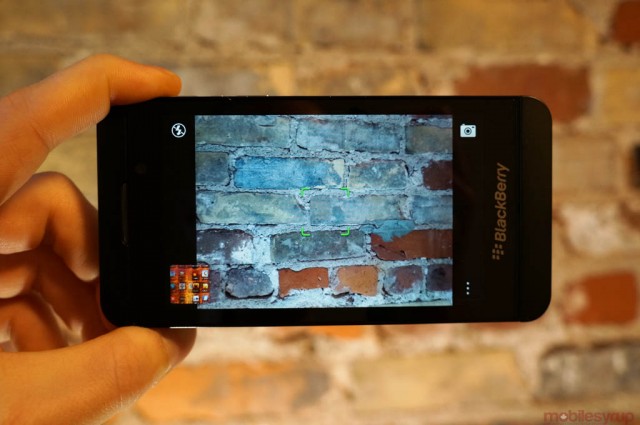
Camera
The BlackBerry Z10 has two cameras, a 8MP back shooter and a 2MP front-facing lens. Let’s get this out of the way first because, if you’re currently a BBOS user you’ve never heard this before: this is the first BlackBerry with a good camera. Yes, the Torch 9810 and, to a lesser extent, the Bold 9900, had back cameras sufficient to use in an emergency, but I still see too many people taking grainy, cringe-worthy photos with Curve 9300’s.
Upgrading to the Z10 is like stepping into a different world, one you’re likely used to if you’re coming from an iPhone 4S or 5 or any recent Samsung Galaxy S. Photos are not only colour accurate and noise-free, but the lens is whip-bang fast. As mentioned above, the only issue I have with the camera isn’t with the photos themselves; rather, I don’t like the lack of touch-to-autofocus, as the camera tends to lose focus quite easily. There is a way to fix focus on a particular object: hold down on the screen for a second until the green framing square turns blue. When you lift your finger it should refocus on that particular object; the problem with this mechanism is its impreciseness, as you’re still at the will of the jumpy f/2.2 lens to find your target.
This is only an issue in situations of less-than-optimal lighting. The Z10 takes photos of amazing quality — truly, truly great — outdoors and in well-lit rooms, but disappoints when there is little to no light. The camera underperforms in lowlight scenarios compared with the Nokia Lumia 920 and iPhone 5, but it’s in line with many popular Android devices such as the HTC One X and Samsung Galaxy S III.
There are two ways to fire in the Camera app. You can shoot in the Auto mode, which allows you to either tap the screen or depress one of the volume keys to activate the shutter. Then there’s TimeShift mode, that much-lauded feature licensed from Scalado. It takes a number of photos in a row (the shutter is really, really quick) and, with some face-detection magic, allows you to turn back time and select the best face for the finished product. In practice, the feature works quite well, and with some editing I was able to nail down a great photo every time.
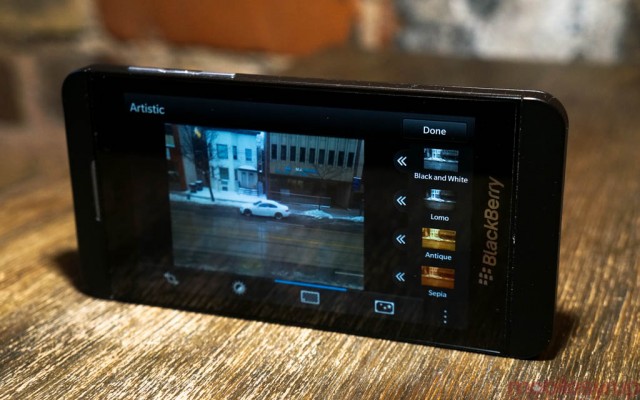
BlackBerry 10 has some robust editing features, along with filters and “scenes” that make for a bit of a localized Instagram. The sharing feature is also quite robust, allowing you to save or share your photo to any number of services like Dropbox, Twitter or BBM. The issue is that if you choose to edit a photo after taking it, once you re-enter the Camera app you’re still in editing mode and have to manually return to shooting. It’s a small but persistent bug that often left me frustrated — and will hopefully be fixed in a future build.
As with its still shots, the BlackBerry Z10 takes great — but not industry-best — 1080p video. Frame rates are smooth and colour is accurate, but the camera has issues adjusting to changing lighting conditions on the fly. The built-in video editor allows for quick trims, rotations and exposure adjustments, while the Story Maker app lets you add video filters, music, titles and multiple edits to your videos. It’s a full-featured solution that is certain to impress.
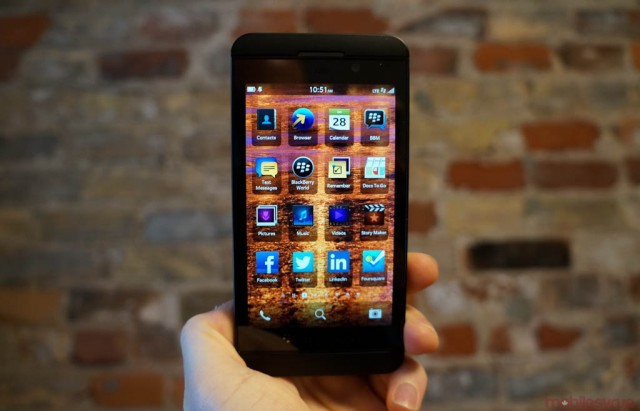
Connectivity
Like any modern phone, the BlackBerry Z10 supports LTE connectivity up to 100Mbps, in addition to 3G up to 42Mbps. Whereas previous BlackBerry devices required a BIS (BlackBerry Internet Service) plan to facilitate much of the magic, such a plan is now only needed for BBM support — the majority of data transport is done over regular TCP/IP. What this means is that the Z10 is much more “cross-compatible” out of the box — it should just work with your LTE-enabled microSIM if upgrading from an iPhone 4S or newer Android — and you won’t need to explicitly change your plan unless you covet BBM.
It also means that the Z10, with its full-page browser and full assortment of bandwidth-intensive apps, will likely use much more data than your previous BlackBerry phone. With LTE speeds, the BlackBerry Z10 loaded pages and downloaded apps and media on par with much of its competition; you also have the option of disabling LTE, which in our experience saved between two and three hours of battery life per charge.
The Z10 can create and edit NFC tags or read external tags, though unlike some of its competition, RIM does not include any in the box. That the Z10 has Bluetooth 4.0 connectivity bodes well for its future accessory compatibility, as we’d expect RIM to work with accessory manufacturers to bring support for third-party devices like smart watches, fitness bands and wireless speaker docks. There’s also a HDMI out for hooking your phone to a TV or projector; this allows users who download video or music content to easily share it with connected stereos or receivers.
As for network speeds, the Z10 achieved roughly what one would expect over the Rogers network: 22-30Mbps down and 6-12Mbps up depending on the location and time of day. And, for those who occasionally still use a smartphone as an actual phone, the Z10 not only sounded perfectly clear and balanced in a loud, but the person on the other end of the line said he could hear me better than on my iPhone. I didn’t even have to prompt him; he just told me that it sounded better than usual.
The bottom-facing speaker, on the other hand, was too soft for even the most modestly-sized rooms, and doesn’t bode well for the phone-as-conference-call crowd.

Battery Life
For the first few days, your BlackBerry Z10 will likely not last the whole day; there is a fair amount of data being synced behind the scenes. Once everything has settled down, you can be certain of at least 10 hours of moderate to heavy usage depending on the number of accounts pushing notifications to your device. Thankfully, RIM thought it prudent to endow the Z10 with a removable battery, and there will be a dual-charging dock available at launch which will charge your phone as well as an extra cell.
In our extensive battery tests, the Z10 lasted just over 10 hours looping a video on 50% brightness with all network connectivity turned off. In our browsing tests, where we had the Z10 reload a page over LTE until the phone died, it lasted roughly eight hours. In other words, the handset, even when used heavily throughout the day, should last as long or longer than the average Android phone, and slightly less than the iPhone 4S and 5.
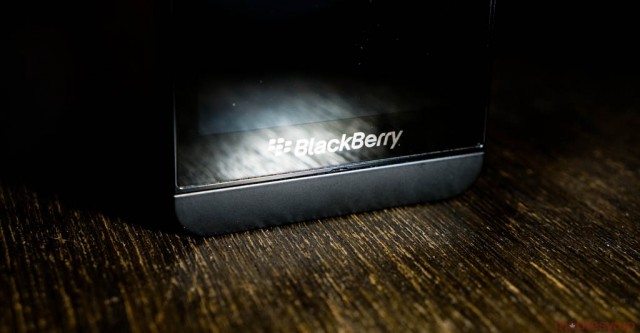
The Competition
We haven’t really touched whether the BlackBerry Z10 can stand on its own in an increasing crowded and competitive market. BlackBerry 10 is a great beginning, a mobile computing platform that RIM hopes will last 10 years or longer. But in its initial incarnation, the Z10 is a must-have upgrade for existing BlackBerry users — in fact, even if you’re rocking a Bold 9900, I’d recommend hopping on the Z10 bandwagon over the equivalent QWERTY BB10 device.
Whether the phone is worth ditching your iPhone or Android for is a different story. At launch, even with 70,000 compatible apps and despite a number of absolutely killer features, the Z10 does not overshadow the iPhone 5 on iOS 6.1 or the Nexus 4 on Android 4.2 Jelly Bean in terms of usability, speed or convenience. It meets and occasionally exceeds the standards we set for it (mainly because, after BlackBerry 7 the bar was set pretty low), but RIM is going to have a difficult time convincing users entrenched in Apple’s or Google’s content ecosystems to make the switch. With the prevalence of iMessage and Facetime, Facebook Messenger, WhatsApp, Kik and others, BBM is no longer the killer app is once was, and the number of North American users has dwindled perilously.
The Z10 is a great phone with a lot going for it; its success will largely depend on how RIM builds out its app ecosystem. It’s encouraging to see so much developer interest already; Twitter, Facebook, LinkedIn, Foursquare, Flixster, Slacker Radio, TuneIn Radio, Angry Birds Star Wars, Asphalt 7, among others, are available on day one. But until we see mainstay apps like Netflix, Flipboard, Instagram arrive and, unfortunately, until developers coincide BlackBerry 10 releases with their iOS and Android counterparts, BlackBerry 10 will continue to be a hard sell. We said the same thing about Windows Phone 8 and though the situation looks less dire for BB10, the same rules apply. Many users will take a wait-and-see approach.
Where it will likely rocket to success is with enterprise users. Out of the box, BlackBerry 10 has support for RIM’s new cross-platform BlackBerry Enterprise Service 10 as well as robust VPN features for IT administrators. Its excellent virtual keyboard, Exchange Activesync support, remote locking and wiping, HDMI out for presentations and BlackBerry Balance makes for a compelling value proposition in a market increasingly comfortable with bring-your-own-device workplace policies.
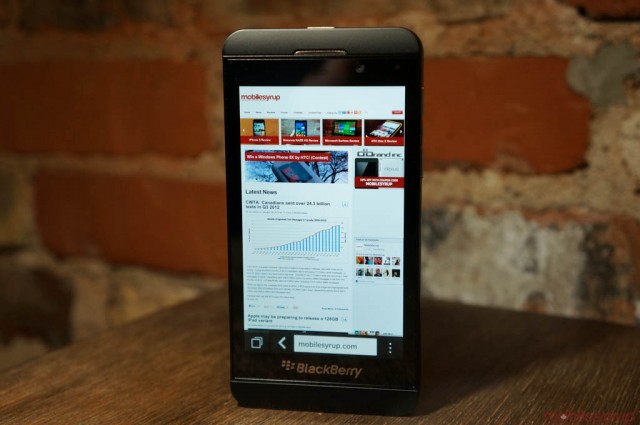
Conclusion
The BlackBerry Z10 makes an excellent first impression, and is one of the most impressive pieces of hardware for a platform debut in recent memory. BlackBerry 10’s ability to consolidate troves of data into a usable space, the Hub, its powerful development tools and a growing community of loyal developers, along with excellent first-party and launch apps, bodes well for its entry into the Canadian market.
That it’s available across all Canadian carriers for less than the equivalent iPhone 5 makes the BlackBerry Z10 not only compelling, but within reach to both consumer and enterprise users alike.
What Works
* Excellent responsive screen
* Superb performance
* BlackBerry Hub is an incredible information consolidator
* BlackBerry 10 feels extremely polished
* BBM Video is a treat
* First-party apps are top-rate
* Great network speeds
* Good battery life
Needs Improvement
* Phone design lacks punch
* Launch-day apps feel perfunctory, occasionally unfinished
* Camera disappoints in low light
* Maps solution cannot compete with Google’s
* Occasional app bugginess
* Twitter app lacks multiple account support
MobileSyrup may earn a commission from purchases made via our links, which helps fund the journalism we provide free on our website. These links do not influence our editorial content. Support us here.

